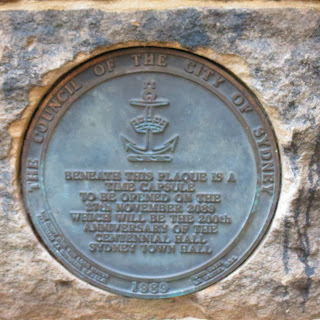Sydney Town Hall - George Street
The Duke of Edinborough, son of Queen Victoria laid the foundation stone on 4th April 1868.
The Sydney Town Hall is a historic and iconic building located in the heart of Sydney, Australia. It holds immense cultural, historical, and architectural significance, serving as a symbol of civic pride and a hub for various events and activities. Here's an overview of the history of the Sydney Town Hall:
Early Development:
- The idea of constructing a grand town hall for Sydney emerged in the mid-19th century due to the city's growing population and importance.
- An international design competition was held, and the winning design was submitted by architects John H. Wilson and Edward Bell.
Construction and Opening:
- Construction of the Sydney Town Hall began in 1868, and the foundation stone was laid by Mayor John Young in 1869.
- The building was constructed using local Sydney sandstone, which was quarried in Pyrmont.
- The Town Hall was officially opened on September 3, 1889, by Lord Carrington, the Governor of New South Wales.
Architectural Style:
- The Sydney Town Hall is designed in the Second Empire architectural style, characterized by its grandeur, ornate detailing, and distinct mansard roof.
- The building features a clock tower and a prominent central dome that add to its visual appeal.
Function and Use:
- From its early days, the Sydney Town Hall has served as a multifunctional space. It was used for civic functions, official ceremonies, concerts, exhibitions, and public meetings.
- The Centennial Hall within the Town Hall is known for its excellent acoustics and has hosted numerous musical performances and events.
Cultural and Historical Significance:
- The Sydney Town Hall holds a special place in the history of Sydney. It has witnessed numerous important events, celebrations, and milestones in the city's growth.
- The building has been a focal point for civic and cultural activities and has hosted prominent figures, including dignitaries, performers, and political leaders.
Restorations and Upgrades:
- Over the years, the Sydney Town Hall has undergone several restorations and renovations to preserve its historical and architectural integrity.
- Efforts have been made to modernize the facilities while respecting the building's heritage features.
Originally the Town Hall was enclosed by iron railings and gates. The gates were removed with the construction of the Town Hall Station. It was decided not to reerect them, but to also remove all the railings on the George And Druitt Street Frontages.
The gates were acquired by St Josephs College, Hunters Hill, and are erected there.
The external walls are made from Pyrmont Sandstone, and the ineternal walls of brick and cement.
The building stands on approx 2 Acres, the external dimensions being 310 ft long, 186 ft wide and height from the ground approx 90 ft.
The Main tower is 182 Ft and 10 inches
The main entrance is on the eastern elevation from George Street. a flight of Wombeyan marble steps and a terrace lead across





























Ten Things You May Not Know About Sydney Town Hall
May 2, 2014 at 7:14am
1. Sydney Town Hall Was designed By J H Wilson, As Part Of A Competition. The First Stage Was Completed Between 1868 & 1884. The Second Stage, Which Included The Grand Hall, Was Built Between 1884 And 1889.
2. Sydney Town Hall Is Built On The Old Sydney Burial Ground, In Use Between 1793 & 1820. By The 1840's Sydney's First Official European Cemetary Had Become An Eyesore And A Health Hazard.
3. Prince Alfred, Duke Of Ediburgh, Was Sydney's First Royal Visitor. He Laid A Foundation Stone For The Town Hall On April 4, 1868, Even Though The Transfer If The Site Had Not Been Finalised.
4. It is Constructed Out Of Honey Coloured Yellow Block Sandstone Quarried From Pyrmont Between 1868 &1889. The Building Is Inspired By The Hotel De Ville In Paris & French Chateaux.
5. It's Clock Was Made By English Clock Makers Gillet & Co In 1883 & Installed Into The Tower In 1884. The Clock Has Been Wound By Hand For More Than 120 Years. The Four Clock Faces Face North, South, East & West. The Hour Hand Is 1.1 Metres Long, &The Minute Hand Is 1.7 Metres.
6. Inventor Of Radio Guglielmo Marconi, Swirched On The Lights In Town Hall During The 1930 Radio & Electrical Exhibition. He Did This From His Yacht In Genoa Harbour In Italy, More Than 19,000km Away.
7. At Age 12, Joan Sutherland Sang In Her First Concert On The Town Hall Stage. Other Performers Have Included Cold Chisel, Jimmy Barnes, Midnight Oil, Johnny O'Keefe...... & YES YES YES.... LADY GAGA.
8. During The Torch Relay For The 1956 Olympic Games In Melbourne, A Prankster Dressed As A Runner & Presented A Smoking Silver Painted Chair Leg To The Then Lord Mayor Pat Hills. The Lord Mayor Went Along With The Joke & Claimed It Was A Trial Run For The Real Exchange.
9. The First National Aboriginal Debutante Ball Was Held In Town Hall In 1968. The Debutantes Were Presented To The Then Prime Minister John Gorton. It Followed The Referendum That Voted To Count Aboriginal People In The Census In 1967.
10. The We Love Town Hall Open Day Is On This Saturday.... May 3, From 10am - 3pm. Residents Are Invited To Bring Town Hall Related Souvenirs And keepsakes From Events That Took Place Over The Years, O Be Assessed For Hostorical Value.... ((I Wonder If There's Going To Be Any Dollar Signs Attached To That???? Everyone Wants To Buy Relics And Stuff From Around The World, Yet, People Don't Like To Shell Out For Our Own Historical Relics, Just Expecting A Donation...










































































